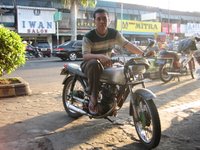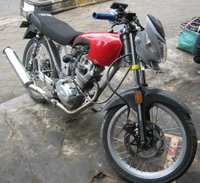From Wikipedia, the free encyclopedia
Honda Super Cub, also known as the Honda Cub or Honda C100, is a small 49 cc 4-stroke model manufactured by Honda Motor Co. Ltd. which is the most produced motorcycle model in the world. It debuted in 1958, 10 years after the establishment of Honda Motor Co. Ltd. The production of Honda Cub became an important event of Japanese automotive history since it marked the beginning of the Japanese motorcycle conquest era. More than 50 million Honda Cubs have been sold worldwide, primarily in Asia and Europe since its launch and this model is still in production especially in Asia despite the introduction of a variety of bigger, more powerful motorcycles.
Specifications
Honda Cub C50
Engine type: SOHC 2-valve 4-stroke 49 cc air-cooled engine (original model: OHV 2-valve 4-stroke engine)
Displacement: 49.0 cc
Compression: 10.0
Bore x Stroke: 40.0 x 39.0 mm
Max Power: 4.0ps@7000 rpm
Max speed: 80 km/h (50 mph)
Transmission: 3-speed (4-speed some models)
Clutch: Wet multi-plate centrifugal
Starter: Kick (some models Electric optional)
Ignition: CDI Magneto
Frame Type: Step-through pressed steel tube
Suspension (F): Leading bottom link
Suspension (R): Swingarm
Brake (F): Leading trailing drum
Brake (R): Leading trailing drum
Dry Weight: 75.0 kg
2004 Super Cub "Street" model
Model History
The Honda Cub debuted in 1958, 10 years after the establishment of Honda Motor Co. Ltd. The name 'Cub' was said to be the acronym of Cheap Urban Bike because the development of this model was aimed to provide a kind of cheap urban transportation in busy cities. The name also likely refers to the earlier Piper Cub, an affordable and extremely popular light aircraft from the 1930s possessing many of the same mechanical qualities of the Honda bike (note that improved versions of the Piper Cub were also called Super Cubs, with spacing in between the words).
After Honda successfully found a way to increase the power and efficiency of 4-stroke engines, the company was optimistic about its ability to use 4-stroke engines to power the most popular motorcycle in the world while other motorcycle companies used 2-stroke engines to power their smaller models. Therefore, there were some critics questioning the viability of the Honda Super Cub project. Despite those critics, Honda Cub which only used 49 cc 4-stroke OHV engine became the most successful motorcycle model in history. The sales of Honda Cub contributed the most in overall Honda's sales and profit. Honda used the slogan You meet the nicest people on a Honda as their slogan when Honda Cub was introduced to the US market.
Years later, the Honda Cub engine configuration was upgraded from pushrod engines to SOHC engines which deliver better volumetric efficiency. Honda also offered bigger displacement options (70 cc and 90 cc models) to provide more power. In the 1970s when the US government required all newer vehicles to use electronic ignition systems in order to pass stricter emission standards, Honda installed a capacitor discharge ignition system (CDI) to replace the earlier contact point ignition system which could no longer meet US standards.
In the 1980s, a larger 100 cc GN-5 engine model was introduced especially for Asian markets. The newer 100 cc model was a major upgrade of the previous Honda Cub models, with new features such as a telescopic front suspension to replace the older leading bottom link suspension, and a more efficient 4-speed transmission to replace the older 3-speed transmission used in older Honda Cubs. The 100 cc model was known as Honda Dream in Thailand and Honda EX5 in Malaysia.
In the late 1990s, Honda introduced their newer NF series motorcycles, known as Honda Wave series which use steel tube frames, front disk brake and plastic cover sets in various displacement options: 100 cc, 110 cc and 125 cc. In European countries, the production of Honda Cub models was terminated to make way for newer Honda Wave models. However, the production of Honda Cubs in Asia and Africa still continues even though newer Honda Wave models have been introduced.
Not only are they continuing, but sales for Super Cubs have increased in Japan with new upgrades on the engine, making it even more powerful, more economical and cleaner than ever before. With all due respect to the newer, plastic body designs, the original Cub model is as popular and as stylish as ever. That's not including the delivery service market, which is what the Cub was originally intended for, unlike in the U.S. or Europe, where the bike was mainly used for leisure. One can't cross a street in Tokyo, Osaka, Kobe or any other city or town in Japan without seeing at least two or three of the classic designed Super Cubs.The plastic-bodied Wave was not designed for delivery or utility, but rather for leisure. Hence the interest in exporting the bike, while keeping the Super Cub design alive and well. (Yamaha has taken a cue from Honda and revamped their Mate series, which is a direct copy of the Honda Super Cub except it sports a 2 cycle engine.)
This year (2006) the Discovery Channel, in a fast-wheeling documentary on motorcycles, rating the best in a top-ten system, deemed the Honda Super Cub "Number One", declaring it "the greatest ever motorcycle". The Honda Wave series or other plastic-bodied designs, it should be noted, were not even mentioned in the list.
One thing is for certain, while other models may undergo vast design changes to appeal to new markets, the Honda Super Cub is timeless. The fact that more Super Cubs have been sold than any other motor vehicle in history says it all.
Reasons for the success of Honda Cub series
Available at a low price compared with other motorcycles. (New: approx. USD$1200)
Easy to ride because of the automatic centrifugal clutch, making it great for beginners to learn riding a motorcycle.
Very low fuel consumption (up to 135 km per liter as of this writing: 2006 Super Cub).
Capable of carrying heavy loads. In developing countries especially in Asia, people use Honda Cubs to carry their agricultural harvests and livestock or their entire family.
Easy to weave through heavy traffic during heavy traffic jams.
Cheap maintenance and abundance of spare parts.
The usage of 4-stroke engines enable the Honda Super Cub to surpass strict emission standards.
Extremely durable, all weather bike.
Regularly achieves very high mileages logged before any breakage or replacement of parts is necessary.
The "Super Cub" has sold over 50 million units making it the biggest-selling motor vehicle in history. It was named the greatest bike ever, beating many of today's top superbikes, on Discovery Channel's Greatest Ever series.
You may want to read this: Honda supercub



